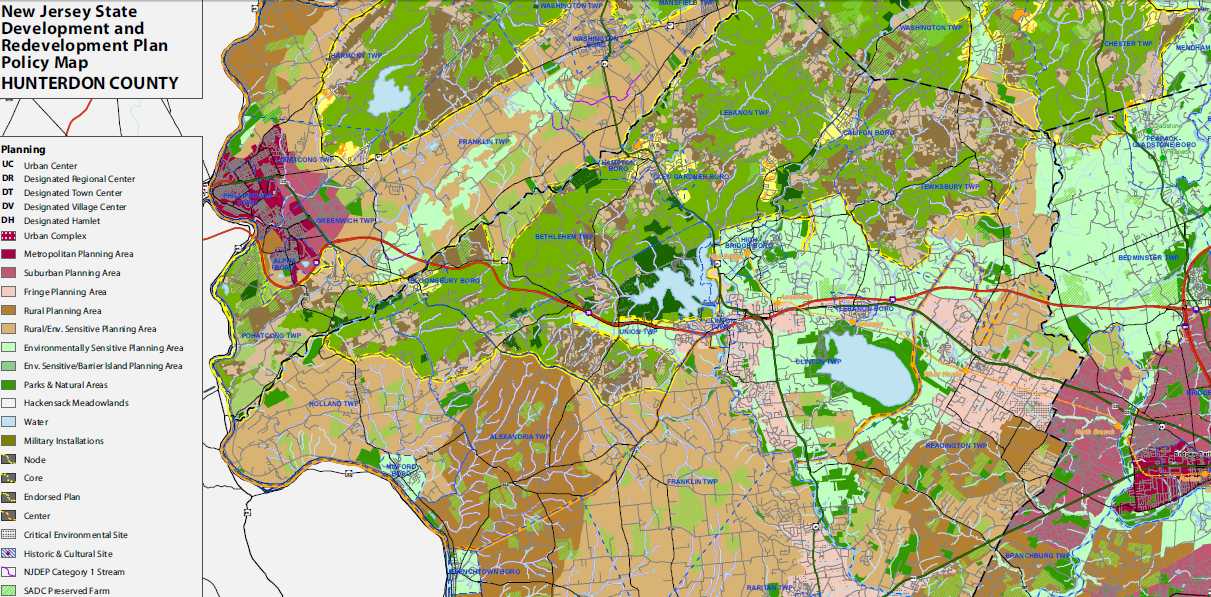Want to know how Clinton Township stopped long-term tax hikes that result from sprawl?
Every three years the N.J. State Planning Commission is supposed to issue The State Plan — a map that defines where the State wants development, and what areas need to be protected from development. Planning Area (PA) 1 is urban. PA-2 is suburban — the main area designated for new growth. PA-3 is transitional. PA-4 is farmland, and PA-5 is environmentally constrained. These designations tell developers where to go build — and they tell us where taxes will skyrocket.
These designations determine how many COAH affordable housing units a town is obligated to build. Local officials who kept Clinton Township in the PA-2 zone invited projects like The Mews and Windy Acres. Our planning area designation has been used again and again as an excuse for sprawl. “We had to approve that high-density project! The State made us do it”
For more than a decade, the Interstate 78 corridor in Hunterdon County and in a good part of Clinton Township were largely in PA-2. That’s why we have been pummeled with over-development. Officials who left us in PA-2 quietly encouraged sprawl — more development, greater population growth, increased demands on public services (especially schools), greater traffic congestion and higher property taxes.
Why have we been in PA-2? Because many years ago local officials were bamboozled with the promise of more State “infrastructure funds” by State officials in exchange for agreeing to put Hunterdon County into PA-2. The local officials agreed to chase the ratables. The funds never materialized. But sprawl and higher property taxes did.
In the last 10 years alone the PA-2 designation in Clinton Towship produced more than $2 billion in new “tax ratables” — but at the same time, State aid declined and our average property tax bill skyrocketed. Property taxes more than doubled in the last decade. Why? Because sprawl costs money — infrastructure, schools, and other municipal services.
PA-2 became one of the key excuses for why Clinton Township permitted huge residential development between 1996-2006. Township officials did not fight the designation, nor did they lobby to have it changed — until a group of concerned citizens got involved and in 2004 lined up other towns to tackle the problem as a group.
The new State Plan has been long overdue — years overdue. In 2004, seven towns along the Route 22/78 corridor got together and submitted their “cross-acceptance plan” to the County — eliminating PA-2 and designating us as farmland, transitional, and environmentally constrained. A battle ensued as developers applied every kind of pressure to preserve PA-2 so they could pave over the rest of the County. Political pressure was brought to bear to stop the change in our designation. Political bosses with ties to developers wanted to see Clinton Township turn into another Raritan Township — wall-to-wall development.
The State Planning Commission has just released the new Draft State Plan. Clinton Township and Hunterdon County are out of PA-2. (The full map is available on the Office of Smart Growth web site. Caution: The pdf file is large.)

State Plan – No more suburban sprawl in Hunterdon
The map shows most of Hunterdon County. Round Valley Reservoir is the large body of water near the middle. The purple to the far right is PA-2 in Somerset County — it stops at our county line. At far left is Phillipsburg — in Warren County. Hunterdon has no PA-2. The target is off our backs — for now.
For now, this is a victory to preserve our rural character, our quality of life, our water supply, and our regional efforts to try to get spiraling property taxes under control. But now is no time to be complacent. Political efforts are already under way to put the growth target (and its costs) on our backs again.
Thanks for this temporary victory are due largely to The 7 Town Group, an activist team of local officials and citizens from Clinton Township, Town of Clinton, Union Township, Readington, Lebanon Boro, Franklin Township, and High Bridge who worked on the plan and lobbied the County and the State hard for our new designation. Office of Smart Growth chief Ben Spinelli gets special kudos for listening and pressing our case at the State. The 7 Town Group grew into the 20 town group that today is suing the Council on Affordable Housing to stop that excuse for more sprawl.
None of this would have been achieved without activism at the local level, involving citizens from many Hunterdon towns. Ask around — who served on your town’s Cross Acceptance Committee? Who did the work? Who fought political bosses to ensure the new plan was adopted? That’s who started the long, hard battle to keep our taxes under control — because stopping sprawl means stopping new infrastructure costs and school costs. (Eliminating PA-2 does not mean stopping all development. But it gives towns more control over how much and how quickly growth occurs.)
Then ask, who tried to STOP Hunterdon County from eliminating PA-2? That’s where you will find the drivers of sprawl and higher taxes. Think twice before you vote for them.
